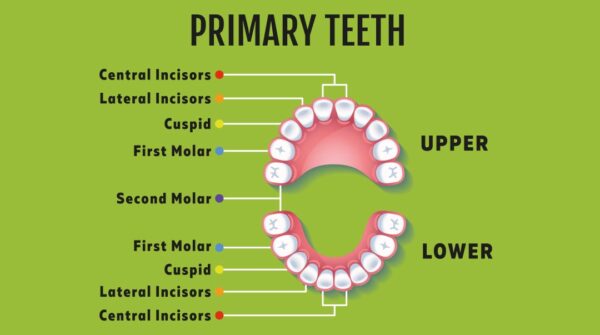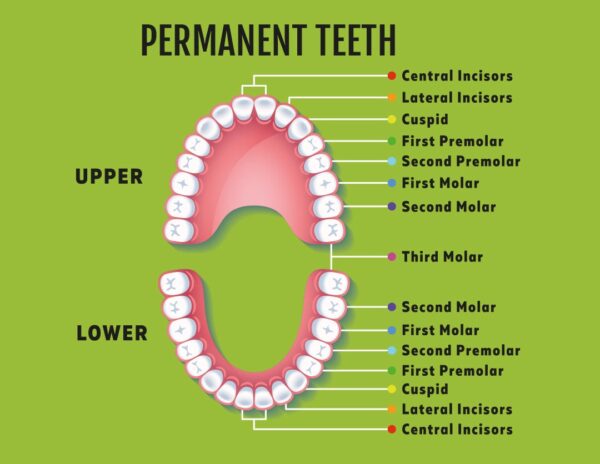In general, babies begin to teethe at around six months of age. However, every child is unique, and some have to wait a full year for the emergence of the first baby tooth (also known as “deciduous tooth,” “primary tooth” or “milk tooth”).
Baby teeth
While primary teeth begin to appear around the age of six months, the tooth buds start developing as of the sixth month of pregnancy. The various parts of the tooth, including the root and the enamel, also start to develop at precise stages during the mother’s pregnancy. In other words, by the time a baby is born, tooth formation is already well underway.
But at what exact age do the baby teeth appear? Below is a timetable illustrating the different phases of teething:
Teething: upper primary teeth
Incisors: between 7 and 12 months
Lateral incisors: between 9 and 13 months
Canines: between 16 and 22 months
First bicuspids: between 13 and 19 months
Second bicuspids: between 25 and 33 months
Teething: lower primary teeth
Incisors: between 6 and 10 months
Lateral incisors: between 7 and 16 months
Canines: between 16 and 23 months
First bicuspids: between 12 and 18 months
Second bicuspids: between 20 and 31 months
At what age do baby teeth fall out?
In most cases, the permanent teeth begin to come in at around six years of age. This is when the 20 baby teeth start to give way to what will eventually be 32 permanent teeth. The permanent teeth push against the baby teeth, wearing away the roots until the teeth fall out. This process is painless, unlike teething, which is very painful.
Even though your child may be tempted to play with a loose baby tooth, pulling it out by force is strongly discouraged, as this can lead to significant bleeding.
The formation of permanent teeth
The first adult teeth to appear are the six-year molars. They come in at the back of the mouth, behind the primary teeth. Below is another timetable showing when the baby teeth fall out and permanent teeth come in:
 Permanent teeth – Upper teeth
Permanent teeth – Upper teeth
Incisors fall out between the ages of 7 and 8
Lateral incisors fall out between the ages of 8 and 9
Canines fall out between the ages of 11 and 12
First bicuspids fall out between the ages of 10 and 11
Second bicuspids fall out between the ages of 10 and 12
Six-year molars come in between the ages of 6 and 7
Twelve-year molars come in between the ages of 12 and 13
Wisdom teeth come in between the ages of 17 and 21
Lower teeth
Incisors fall out between the ages of 6 and 7
Lateral incisors fall out between the ages of 7 and 8
Canines fall out between the ages of 9 and 10
First bicuspids fall out between the ages of 10 and 12
Second bicuspids fall out between the ages of 11 and 12
Six-year molars come in between the ages of 6 and 7
Twelve-year molars come in between the ages of 11 and 13
Wisdom teeth come in between the ages of 17 and 21
Learning proper dental hygiene
When children lose their baby teeth, it’s an ideal time to teach them how to take care of their new permanent teeth. Teaching them good oral hygiene practices from a young age will help build a solid foundation for life! Healthy teeth are synonymous with good health, in addition to promoting good self-esteem.
You can count on the team at Clinique Dentaire Charles Trottier to offer you appropriate treatments and great advice to care for the teeth of your loved ones, both young and old! Contact our clinic in Vaudreuil-Dorion to learn more about the services we offer.





 Permanent teeth – Upper teeth
Permanent teeth – Upper teeth


